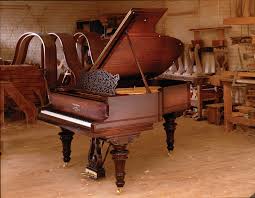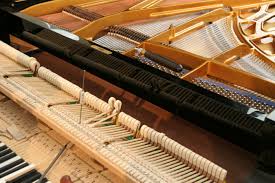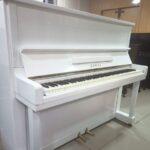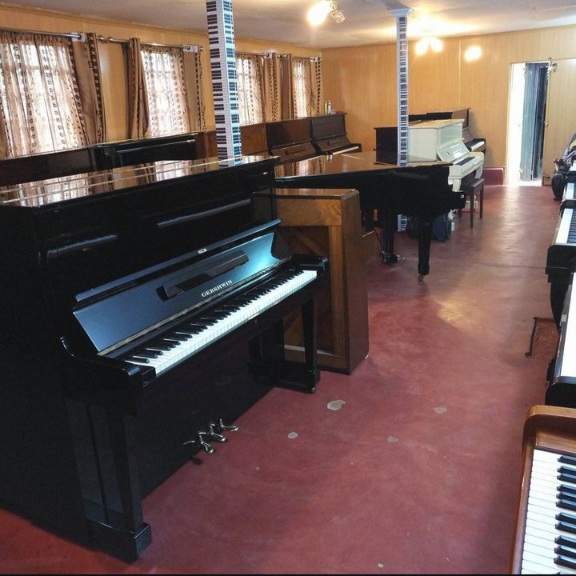PIANO RELATED TERMS DEFINITIONS
Rebuilt Piano Definition
A used piano that has been disassembled, inspected, and repaired as necessary with replacement of all worn or deteriorated parts, re-assembled, tested, and approved to at least the same tolerances as a new piano of like manufacture.
Reconditioned Piano Definition
A used piano that has been put back in good condition by cleaning, repairing and adjusting for maximum performance with replacement parts where specifically indicated.
Piano Tuning Definition
Piano tuning is the aligning of the musical pitch of the various notes of the piano, by adjusting the tension of the piano’s strings, in order to achieve a desired musical effect. Preferences in desired musical effects and methods in achieving those preferences will vary. Piano “tuning” does not involve the functioning of a piano’s key mechanism. (The “tune-up” of an automobile engine may involve keeping machinery running smoothly, but piano “tuning” by itself does not.)
As a conscientious piano owner, you probably have your piano tuned regularly by a qualified technician. You may, however, notice a deterioration of its performance despite regular tuning. It’s important to note that tuning is only the adjustment of the system of strings and pins that determines the pitch of each string. Your piano also requires a periodic servicing called regulation, which attends to the mechanical parts which cause strings to sound when keys are played and affect the sound through use of the pedals.
What is regulation and how does it affect my piano’s performance?
Regulation is the adjustment of the mechanical aspects of the pianos to compensate for the effects of wear, the compacting and settling of cloth, felt, and buckskin, as well as dimensional changes in wood and wool parts due to changes in humidity.
The three systems involved in regulation are the action trapwork and damper system. The action is the mechanical part of the piano that transfers the motion of the fingers on the keys to the hammers that strike the strings. It is comprised of over 9,000 parts which require adjustment to critical tolerances to be able to respond to a pianist’s every command. The trapwork is the assemblage of levers, dowels and springs that connects the pedals to the action affecting sustain and dynamics. The damper system is the mechanical part of the piano that stops the vibration of the string when you release the key and is controlled by the key and pedal systems.
If I have my piano tuned regularly, why do I need to have it regulated?
While tuning corrects the pitch of your piano, it is only one component of a complete maintenance program. Regulation attends to the touch and uniform responsiveness of your action, all vital to making each performance pleasurable. In addition, regulation ensures that your instrument is capable of producing a wide dynamic range — a critical factor, particularly in pianissimo passages
Music is one of the most complex vehicles for expression. Its beauty is reliant upon personal dynamics and tempi. These changes require extremely fine adjustments to respond to the pianist’s nuances and subtle shadings. A smooth, even response throughout the entire range of the keyboard and an extremely quick action capable of playing rapid passages and repeated notes evenly is essential. Outstanding response is essential for a pianist to create an outstanding performance.
Do all pianos need to be regulated?
All upright and grand pianos need periodic regulation to perform their best. Frequency of regulation is dependent upon amount of use, exposure to climatic changes, and the instrument’s quality, age and condition. New pianos may require regulation in their first year because settling and compacting of parts sometimes necessitates adjustment.


How often is regulation needed?
Only you and your technician together should decide how frequently your piano needs regulation. Several factors can contribute to this. The intensity and number of hours your instrument is played, and climatic conditions are all determinants. A piano kept in relatively consistent conditions which are neither too wet nor dry, optimally at a temperature of 68 degrees Fahrenheit and 42 percent relative humidity, will require less adjustment
The quality of the instrument itself also can affect frequency of regulation. Some manufacturers decrease costs by not going over the regulation and voicing processes in the factory as much as needed. Reputable retailers sometimes do the necessary regulation themselves prior to selling the pianos, but others do not.
Also, performance instruments may require some regulation before each use, due to the higher demands placed on them.
What are the signs that my piano needs regulation?
If you instrument displays a lack of sensitivity or a decreased dynamic ranges, it’s a candidate for regulation. If you notice that the keys are not level (some higher or lower than the rest), the touch is uneven or that the keys are sticking, the need for regulation is indicated. However, a sluggish action or deep grooves in the hammers indicate the need for reconditioning or repair. Ask your technicians to show you what needs adjustment on your piano
No amount of practice can compensate for a poorly maintained action. Poor legato touch, chord playing where all notes of the chord don’t speak clearly, a gradual loss of subtlety in phrasing and an inability to execute quick passages or note repetitions evenly may be the fault of the piano — not the player.
Why is reconditioning or rebuilding of the mechanical systems sometimes necessary prior to regulation?
Prior to regulation, your technician will assess the condition of your instrument. If it has badly worn parts or if there has been corrosion or moth damage, the piano may not be able to be properly regulated without some repair or replacement of parts.
Reconditioning is the process of putting your piano back in good condition by cleaning, repairing, and adjusting your instrument for maximum performance with replacement parts only where specifically indicated. If you piano has deteriorated beyond simple reconditioning, it may need to be rebuilt.
Rebuilding involves complete disassembly, inspection and repair as necessary with replacement of all worn or deteriorated parts. The piano is then reassembled, tested and adjusted to the same or similar tolerance and performance as when it was new.
Your piano is a major investment which deserves to be protected through regular servicing by a qualified technician. Properly maintained, your piano will sound its best and give you and your family a lifetime of enjoyment.
Your piano is designed to sound its best when tuned to A-440 (A above middle C vibrates at 440 cycles per second), the international pitch standard. At this pitch, power and tonal range are optimum and your piano will match the pitch of other instruments. When your piano varies from A-440, pitch adjustments are required to bring it back to standard. By always maintaining your piano at standard pitch, you create long-term tuning stability because the strings and structure stay in equilibrium. You also ensure proper ear training because you always hear your music in the correct key.
Why does a piano’s pitch change?
Piano strings change pitch for two primary reasons: the initial stretching and settling of strings when the piano is new, and soundboard movement due to humidity variation. In the case of new pianos, the pitch drops quickly for the first couple of years as the new strings stretch and wood parts settle. It’s very important to maintain any new piano at the proper pitch during this period, so the string tension and piano structure can reach a stable equilibrium. (Most piano manufacturers recommend three to four tunings the first year, and at least two per year after that.)
Aside from this initial settling, climate change is the main cause of pitch change. That’s because the piano’s main acoustical structure — the soundboard — is made of wood. While wooden soundboards produce a wonderful sound, they also react constantly to climate changes. As the relative humidity goes up, the soundboard swells, increasing its crowned shape and stretching the piano’s strings to a higher pitch. Then during dry times the soundboard flattens out, lowering tension on the strings and causing the pitch to drop. The drop in the dry season tends to exceed the rise during humid times, so the net result is a drop in pitch each year that the piano isn’t serviced.
Nairobi PiANO TECHNICIANS
Won’t tuning restore my piano’s pitch to A- 440?
If a piano has gone without tuning for an extended period, its pitch may have dropped far below A- 440. This means that each of its approximately 220 strings needs to be tightened considerably, adding tremendous additional tension to the piano’s structure. The problem is that as each string is tightened, the additional load causes the pitch of previously adjusted strings to change. Thus it is impossible to make a substantial change in pitch and end up with a fine, accurate tuning in one step. Instead, a process called “pitch raising” must first be done, in which all strings are raised to their correct average tension levels. (Likewise, when a piano’s pitch is higher than standard, a pitch lowering procedure must be done to reduce string tensions to approximately correct levels.) Only then can the piano be accurately tuned. In other words, accurate tuning is only possible when all strings are so close to their proper tension that only small further changes are needed during tuning. These small changes then do not disturb the tuning of other strings.
How far from standard pitch must a piano be before a pitch raise is necessary?
Just when a pitch raise or lowering is necessary depends upon how accurate the final tuning must be, and the size and quality of the piano. Any net change in a piano’s string tension during tuning will distort the final result and reduce stability. Realistically, a pitch difference of a few percent can usually be accommodated successfully during tuning. For average situations, when a piano’s pitch is noticeably different from that of other standard pitched instruments, a pitch correction procedure is necessary before tuning. Whenever exact pitch level is critical, such as in concert or recording instruments, any pitch deviation must be corrected before tuning.
How long does a pitch raise take?
A pitch raise is essentially a special tuning procedure designed to leave the piano approximately in tune. For moderate pitch corrections the procedure takes about the same time as a tuning, or less. Extreme pitch changes may require two separate pitch adjustments.
The pitch adjustment and subsequent tuning may be done in one visit, or the tuning may be scheduled for a short time later depending upon how far the pitch had to be changed. In general, the longer a piano has gone without regular service, the more tunings will be required to reestablish tuning stability.
Like your car, your piano is a major investment which deserves regular servicing to keep it working well and preserve its value. Most importantly, the well-maintained piano sounds better, plays better, and gives you and your family a wealth of musical pleasure.
Your piano is made primarily of wood, a versatile and beautiful material ideal for piano construction. However, being made of wood, your piano is greatly affected by humidity. Seasonal and even daily changes in humidity cause wood parts to swell and shrink, affecting tuning stability and touch. Extreme swings in humidity can eventually cause wood to crack and glue joints to fail.
Other materials in your piano also are affected by changes in moisture content in the air. The many felt and leather parts in your piano’s action can change dimension, affecting regulation and friction, or stiffness of the touch. Very high humidity can even create condensation on metal parts such as strings, tuning pins and hardware, eventually causing them to rust.
How does humidity level affect my piano’s tuning?
Swelling and shrinking of the piano’s soundboard is the most immediate and noticeable effect of humidity change. The soundboard, a sheet of wood approximately 3/8 of an inch thick, is made with a slightly crowned shape. The strings pass over the soundboard and are connected to it by a wooden piece called a bridge. The upward crown of the soundboard presses the bridge tightly against the strings.
As the moisture level in the soundboard increases during periods of high relative humidity, the crown expands and pushes the bridge harder against the strings. The strings are stretched tighter and the piano’s pitch rises. Because this increase in crown is greater in the center of the soundboard than at the edges, the pitch rises more in the middle octaves than in the bass or treble registers.
During periods of low relative humidity the soundboard shrinks, reducing the crown and decreasing pressure against the strings. The pitch drops, again with the greatest effect noticeable in the center of the keyboard. When relative humidity returns to its previous level, the average pitch of all the strings will return to normal, although the exact pitch of individual strings will be slightly changed from their original settings. Thus, a piano only will stay in tune as long as the relative humidity level in the air surrounding the soundboard remains constant. Extreme humidity changes require making greater changes in string tension to bring the piano into tune. This upsets the equilibrium between the string tension and the piano frame, and the piano never becomes stable.
What is relative humidity?
Wood swells and shrinks in response to changes in the relative humidity of the air around it. Relative humidity (RH) is the amount of moisture contained in the air, compared to the maximum amount of moisture that the air is capable of holding. The moisture content of air is affected by weather as well as conditions and activities within the home, while the moisture- holding capacity of air varies with temperature. One way of thinking about RH is that it is a measure of air’s tendency to absorb or release moisture to its surroundings. Thus when the RH of air in a room increases, moisture will tend to transfer from the air to wood and other absorbent materials in the room. When the RH of air decreases, moisture will transfer from other materials back into the air. The RH of the atmosphere is always changing by the hour, and more dramatically, with the seasons. Consequently, the wood and felt parts in your piano are constantly changing dimension as they absorb and release moisture.
Since RH depends upon the temperature and moisture content of the air, it is not possible to maintain a constant RH by controlling room temperature alone. In fact, maintaining an even temperature while moisture content varies will cause RH to change.






